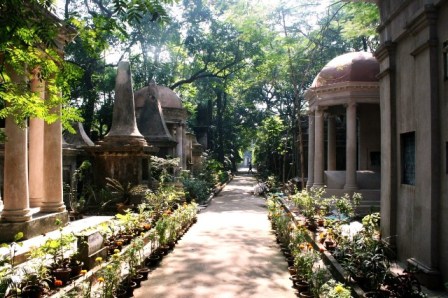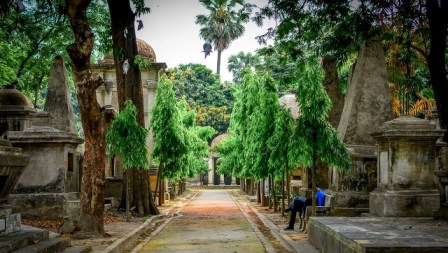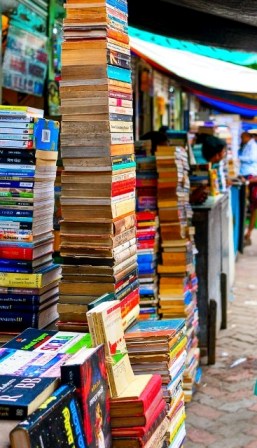HIDDEN KOLKATA
By Margaret Deefholts
Calcutta, now known as Kolkata, doesn't have Mumbai's urbane sophistication, or New Delhi's political overtones. It lacks the flamboyance of Rajasthan, and has no splendid monument like the Taj Mahal on display. Yet, it is a remarkable city that reveals itself slowly and shyly, one that draws me back again and again, each time revealing a new layer, a different angle, an altered perspective.
More than any other Indian city, Calcutta – that is old “Calcutta” as opposed to modern “Kolkata” – bears the imprint of Britain's presence in its landmarks: the imposing Victoria Memorial with its treasure trove of historical artifacts, and Government House, once the abode of the British Viceroy.
Just as significant is the red brick building that stretches for an entire block on BBD street (formerly Dalhousie Square). Once known as the Writers' Building, it is where the Company's clerks, known as “writers” labored under punkhas (cloth fans attached to rods and suspended from the ceiling) pulled back and forth by punkha coolies. Today their successors, known as babus, work under slow-turning electrical ceiling fans and still process Government files tied up (literally!) in red tape!
All these are part of the tourist's sight-seeing agenda. But there is an older, less known city where few visitors go.
A short distance away from Writers' Building, is St. John's Anglican church, built in 1787 and modelled after London's St.-Martin-in-the-Fields. I have a personal connection to this lovely little church, for it was where my paternal grandmother was baptised.
St. John's Church
Mausoleum of Job Charnock
A pathway in the churchyard leads to the mausoleum of Job Charnock, reputedly the founder of Calcutta in the mid 1600s. Here too is a plaque which honours the 123 British soldiers who suffocated to death in what came to be known as the infamous Black Hole of Calcutta – a tragedy that led ultimately to the defeat and death of the perpetrator and nawab (ruler) of Bengal, Siraj-ud-Doulah by Sir Robert Clive, and the annexation of his territory to the East India Company. It was the start of the Company's transformation from a mere trading operation to ruling almost the entire subcontinent within the next couple of centuries.
Several other notable tombs are also in the churchyard. Mrs. Francis (‘Begum') Johnson must have been quite a gal—born in 1725, she married four times and lived to the ripe old age of 87. A rare thing in a country where few survived more than the length of “two monsoons” – i.e. two years.
Speaking of colonial graves, the historical South Park Street cemetery is open to visitors, and although a bit spooky with its old mouldering gravestones, it is poignant reminder of the men and women who lived, worked, loved and died on these foreign shores. The tombs are elaborate – many edifices have fine marble sculptures and poetic inscriptions. Tucked away in a corner is a monument that resembles a miniature Hindu temple, with its arches and cupolas—the grave of Charles “Hindu” Stuart. He earned the sobriquet, because of his fascination with all things Indian, often wearing a dhoti (loin cloth), visiting Hindu temples, dipping in the Ganges river, and mastering several Indian languages. Also laid to rest here is Walter Landor Dickens, son of Charles Dickens and William Makepeace Thackeray's father Richmond Thackeray.
.jpg)
South Park Street Cemetery : Wikipedia Commons

South Park Street Cemetery: Wikipedia

South Park Street Cemetery: photographer unknown
Off the well-worn tourist track is College Street which gets its name from nearby colleges and the Presidency University. The street is thronged with hand pulled rickshaws, beeping taxis and a holy cow or two. Book shops sell fiction, college text books, technical literature and rare out-of-print publications. Stacks of second-hand books and magazines sprawl across the sidewalk. Bargaining is loud and vociferous.

Book stall on College street: photographer unknown
Handpulled rickshaw with passenger and books – College Street
This is also where the famed India Coffee House café is to be found at the top of a narrow staircase with dusty balustrades . The waiters wear turbans with cockatoo-like plumes and serve patrons with an air of haughty condescension. The room buzzes with conversation, for this is the haunt of Bengali poets, artistes and literati—none more famous in years gone by than Nobel Prize winner, Rabindranath Tagore, and film luminary Satyajit Ray. The coffee is rich, the samosas mediocre.
India Coffee House Café
Cockatoo Turbanned waiters at India Coffee House
Some aspects of hidden Kolkata can be unsettling. While visiting an off-the-beaten track Jain temple in a Kolkata suburb, I chance upon a group of men in a sun-drenched courtyard —all of them stark naked. A few conventionally dressed visitors sit cross-legged on the ground. The nudists catch sight of me, and one of them folds his hands in a traditional greeting, and gestures towards an empty chair. “Namaste, madame,” he says. “Welcome to our temple.”
I try not to look as flustered as I feel, and stutter, “Um,,, shukrya …thank you.”
Jain Temple Monks
These monks belong to the monastic Digambara sect of Jainism—ascetics who renounce all material and carnal desires, and observe rigid dietary restrictions. I grope for words and sensing my discomfiture the monk continues, “We are meditating in silence; there is no need to converse. If you like please join us.” He pauses and gestures towards my camera, “You may also take pictures, but please do so respectfully.” He falls silent, and the only sound lying on the muggy afternoon air is the persistent call of the Indian koel bird. I tiptoe away a few minutes later.
It isn't often that you come across a guy stroking the naked breast of a voluptuous woman in public and in broad daylight. But it is commonplace here in Kumartuli, or Potters Colony where more than a thousand craftsmen ply a traditional profession that has been handed down through the generations. I walk through a maze of cluttered lanes, marveling at the display of hundreds of statues of manly gods and curvaceous goddesses—Krishna, Ganesh, Kali and Durga—each born out of the potter's skill and artistic imagination.
Kumartuli effigies
Kumartuli lane
Kumartuli damsels
Elegant lady, Kumartuli
Here, a worker moulds wet clay over a bamboo frame where it will dry for a couple of days after which it will be painted and adorned in jewelry; a bit further along the lane, an artist fashions delicate lace necklaces and bracelets. Around another corner statues of notable statesmen like Mahatma Gandhi look on benevolently at passersby.
Colourful Ganesh
Potter at work
Photo 17. Finishing touches
Regrettably my stay in Kolkata isn't long enough to take in the popular festival of Durga Pooja in October. That's when these effigies will be taken in procession, accompanied by music and chanting, to be submerged in the Hoogly river in a ritual as ancient as India itself.
IF YOU GO:
More Information :
South Park Cemetery: South Park Street Cemetery
Kumartoli: https://kolkatacitytours.com/kumartuli-kolkata-potter-studio/
India Coffee House: College_Street_Coffee_House
Where to Stay: AirB&B run by Jharna Bose/Ishwari Bose. Situated in south Kolkata (Lakes area). Clean, well run and welcoming. Highly recommended.
Photos: by Margaret Deefholts unless attributed otherwise.